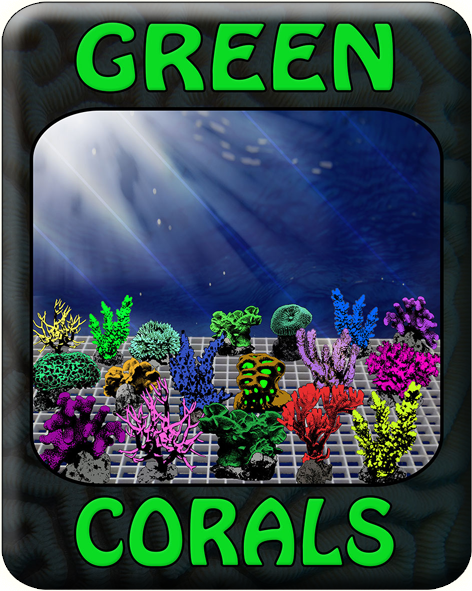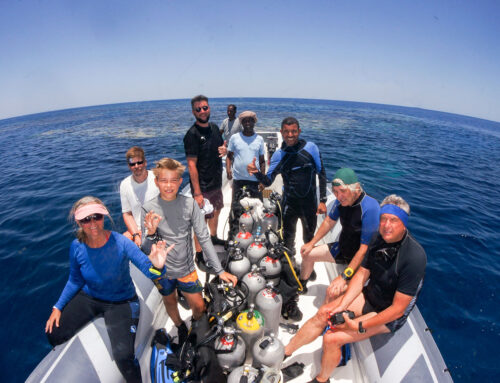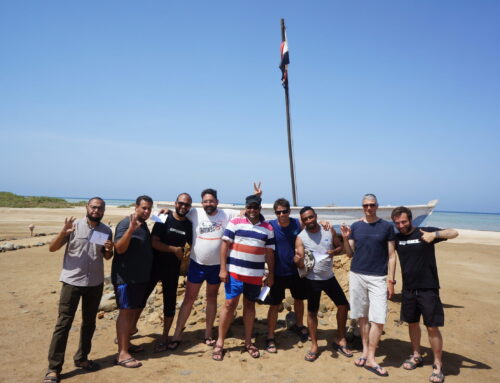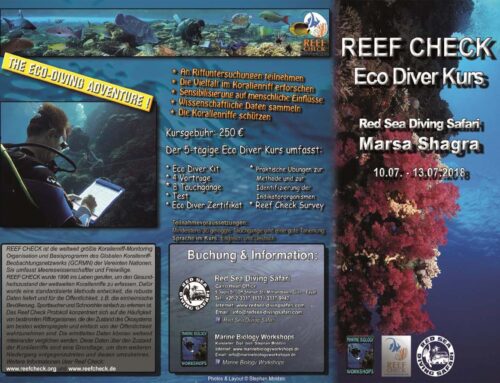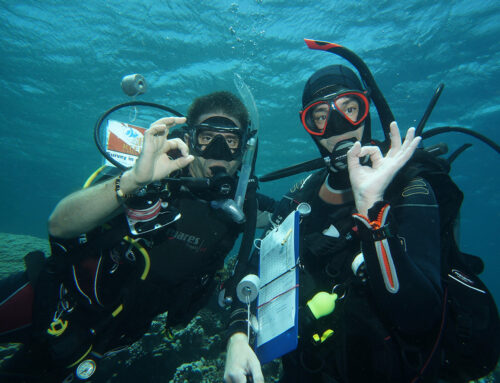Reef Check EcoDiver course & surveys 2021 at Marsa Shagra
From 5th to 12th august 2021, another Reef Check course with subsequent reef surveys took place again as part of our reef monitoring program at Red Sea Diving Safari (RSDS).
Like last time we were located in Marsa Shagra again.
In 2020 the Reef Check activities unfortunately had to be cancelled due to a certain nasty little virus….
But this year there were almost no obstacles in our way (except some not worth mentioning travel formalities) and so the first course and surveys since 2019 was unstoppable !
Who could, was vaccinated and tested anyway, RSDS had implemented an appropriate hygiene concept, the entire staff had already been vaccinated in spring.

Our dynamic survey team of seven participants came from Egypt, Austria, Czech Republic and Germany, ranging in age from 10 to 64 years. Some of them had been regularly participating in the surveys for many years. Quickly they all got to know each other during the EcoDiver course and formed alternating buddy teams later on for the surveys.
The EcoDiver course pays special attention to human impacts on the reef: overfishing, mechanical damage, overfertilization, pollution and trash, as well as coral bleaching or coral diseases and also indication of possible imbalances within the ecosystem. For the four course participants, this approach was new – as recreational divers, they had previously paid their attention especially to (large) fish, or conspicuous corals and invertebrates, and not so much to “how the corals are doing”, details in the substrate cover, feeding scars, algae & sponges, fishing lines or coral damage by divers or boats. You can say the “underwater perception” changes through the course.
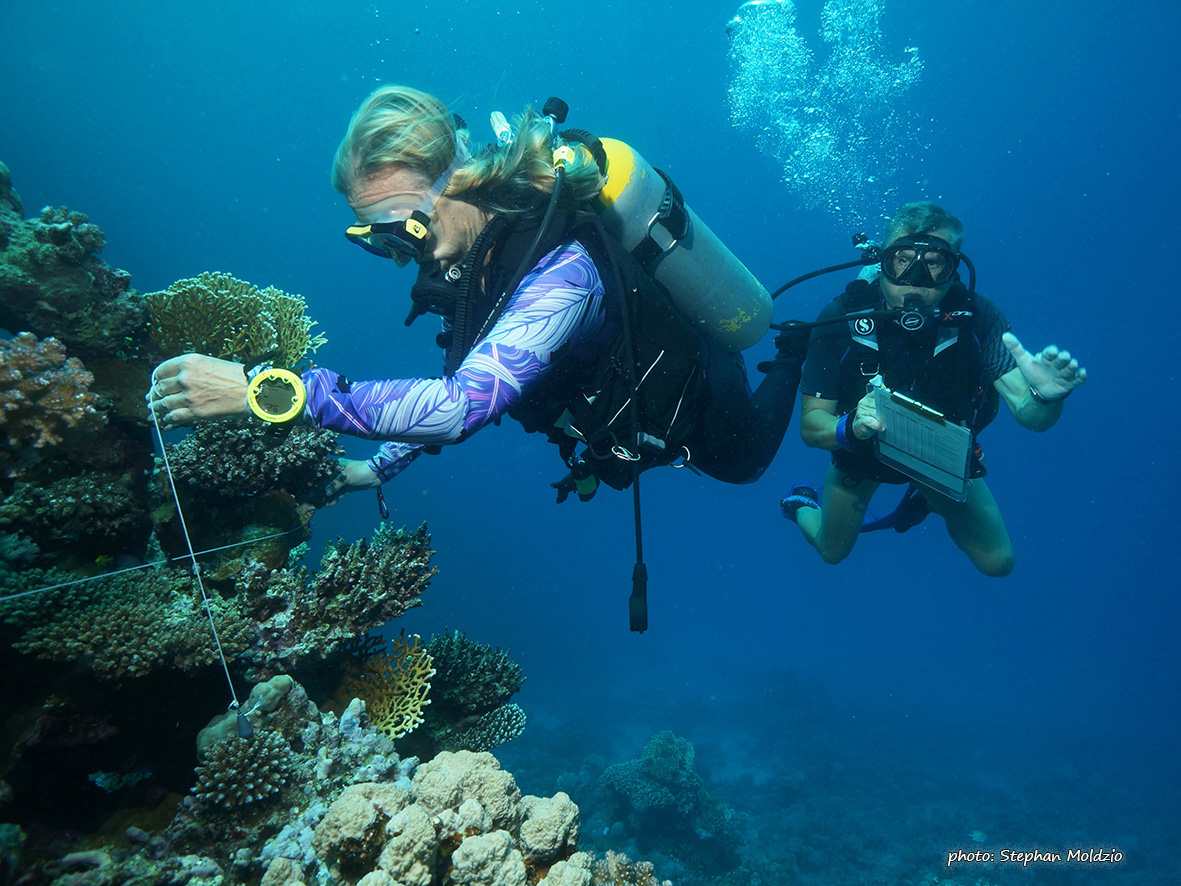

The 4-day EcoDiver course includes four theory presentations: Introduction & Reef Check method, Fish, Invertebrates & Human Impacts, Substrate (corals, algae, reef rock, sand etc.).
The “Beach Exercise”, where the Reef Check method is practiced on land, took place for the first time not on the beach but in the restaurant. Nevertheless, we had a lot of fun again and could hardly wait to apply what we had learned during the real surveys in the reef.
We conducted two training dives in the reef every day, practicing indicator organism identification and underwater hand signals, as well as conducting a test survey.
At the end of the course, were the tests. But that was no problem at all, all participants successfully passed and are now certified Reef Check EcoDivers.
There were a total of 200 photos of fish, invertebrates, substrate categories, as well as human influences, such as coral rubble, garbage or fishing lines to recognize… and some one even expressed that the tests had been fun…
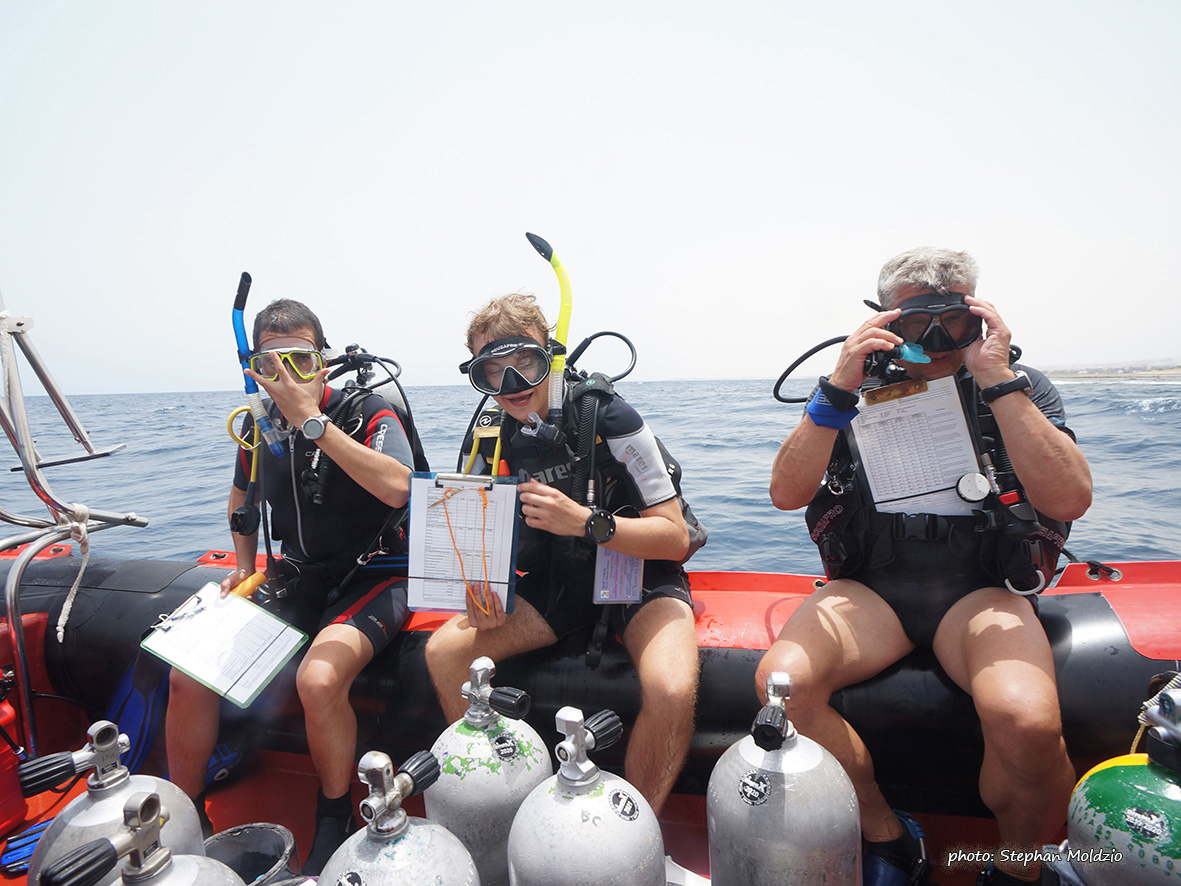
As usual, the course was followed by five Reef Check Surveys along two depth contours. These were the sites for our reef surveys this time:
- 1
Abu Nawas Garden
- 2
Marsa Shagra nord
- 3Marsa Shagra süd
- 4
Sharm Abu Dabab
- 5
Marsa Gabel El Rosas nord
1
The buddy teams rotated through over the course of the days. Thus, each participant was conducting the three different surveys (fish, substrate and invertebrates/human impacts) at least once and recorded the data.
Sometimes the egyptian marine biologist formed a buddy team together with the 10 year old Open Water Diver, or the newly certified EcoDiver with the Divemaster with 10 years of Reef Check experience..
The first survey started at Sharm Abu Dabab. The substrate team determined a coral cover of 41 % (hard corals (HC) 38 % ; soft corals (SC) 3 %) along the 8.5 m depth contour. In the shallower, i.e. light-rich 3.5 m depth contour, the total coral cover was even 55 % (HC 51 % ; SC 4 %).
In the fish survey at Sharm Abu Dabab, as at almost all other sites, butterflyfishes were the most abundant fish group with 5.75 (at 8.5m depth) and 7.5 (at 3.5m depth) individuals per 20 m transect. Parrotfish followed with 4 (at 8.5m depth) and 4.25 (at 3.5m depth) individuals per 20 m transect. Grouper, an indicator of overfishing, averaged only one individual per 20 m transect across both depth levels. In 2019, a new jetty was built just about 20 m from the survey site, possibly increasing fishing here.
We did not detect any coral damage or trash.
For invertebrates, we found only reef clams at both depth levels. The nocturnal sea urchins, shrimp or lobsters hid deep in the crevices and caves in the reef. During our night dives we could observe them, as well as many other interesting creatures.
This was followed by surveys at Marsa Shagra house reef, at the north and south side of the outer reef. In Marsa Shagra north we found the highest coral cover of all survey sites with 74 % (3.5 m depth) and 59 % (8.5 m depth), as well as the most parrotfish and groupers, with an average of 8.5 and 1.75 individuals per 20m transect, respectively.
In Abu Nawas Garden we found the most butterflyfish with 10 individuals per 20 m transect.
The survey site on the north side of the long and narrow bay of Marsa Gabel El Rosas had the lowest coral cover with 50 % (3.5 m depth) and 26 % (8.5 m depth) respectively, but this may be due in particular to the shaded and steep reef slope.
Water temperatures were consistently 30 °C at all survey sites down to about 10 m depth. Below that, the temperature slowly decreased, dropping to about 27 °C at 40 m depth. In the shallow water of the bay and on the reef flat, the temperature was as high as 36 °C in the afternoon, yet there was little mortality or coral bleaching evident in the corals in this area. This is because the corals living here, together with their symbiotic algae, the zooxanthellae, are adapted to these high temperatures: In summer, at low tide and in the afternoon, temperatures are regularly in this extreme range.
Consequently, only those species that can cope with these high temperatures can settle permanently in these shallow areas: First of all, the bright pink hood coral Stylophora pistillata, but also the brush coral Pocillopora, massive Porites-coral, brain corals Platygyra and also some branching Acropora species.
Certainly some corals were a bit lighter in colour, due to the increased temperatures in summer – caused by a lower zooxanthellae density. Here, however, one cannot yet speak of “coral bleaching“, in which the coral in a state of distress practically expells all its zooxanthellae. Overall, we observed only a few cases of coral bleaching, where the coral was almost white and had completely expelled its symbiotic algae.
The corals of the intact reefs around Marsa Shagra are diverse and have a good number of species:
The stony corals of different growth forms – from plate-, branching- or column-shaped, to massive blocks – form the foundation of the reef with their calcareous skeletons: habitat for a fascinating and closely interwoven community of countless organisms from algae to crustaceans, mollusks, cnidarians to echinoderms and worms. Because of their symbiotic algae, the zooxanthellae, the stony corals are predominant in the light-flooded shallow areas down to about 20 m depth.
The soft corals, with their eight-fold symmetry and eight feathered tentacles, are most common at the end of the bay where there is a high sedimentation.
Their relatives, the sea whips and gorgonians are more common in the deeper areas, as they usually lack zooxanthellae and feed primarily on catching zooplankton. A moderate to strong current is of course very beneficial to them, as a continuous supply of plankton.
Elphinstone
The gorgeous Elphinstone Reef, about 15 km from the coast, has lush soft coral forests on its plateaus and drop-offs, as well as huge sea fans, sea whips and black corals, due to these current-rich conditions. A breathtaking abundance of fish swarm around the reef like a cloud of several “onion skins”:
The “Wall-of-Anthias” is formed closely to the reef by myriads of sea goldies (Pseudanthias squamipinnis). In between, of course, there are numerous predators, such as groupers. Also, wrasses and butterflyfish are constantly searching for invertebrates, wandering parrotfish are picking for algae on the ground. The largest species of wrasse is the vulnerable and strictly protected Napoleon wrasse, which can crack even the largest and hardest-shelled invertebrates with its bulging lips: Besides large snails or lobsters, even the coral-eating crown-of-thorns starfish with their poisonous spines are on its menu.
Shoals of fusiliers form the second “onion skin”. They are constantly on the hunt for small plankton organisms in the blue water near to the reef.
Out in the further “onion skins” there are fast-swimming predators such as snappers, jacks and barracudas. Finally, at the top of the food pyramid are the sharks as top predators. Even dolphins, dugongs and turtles are not safe from large oceanic whitetips or tiger sharks.
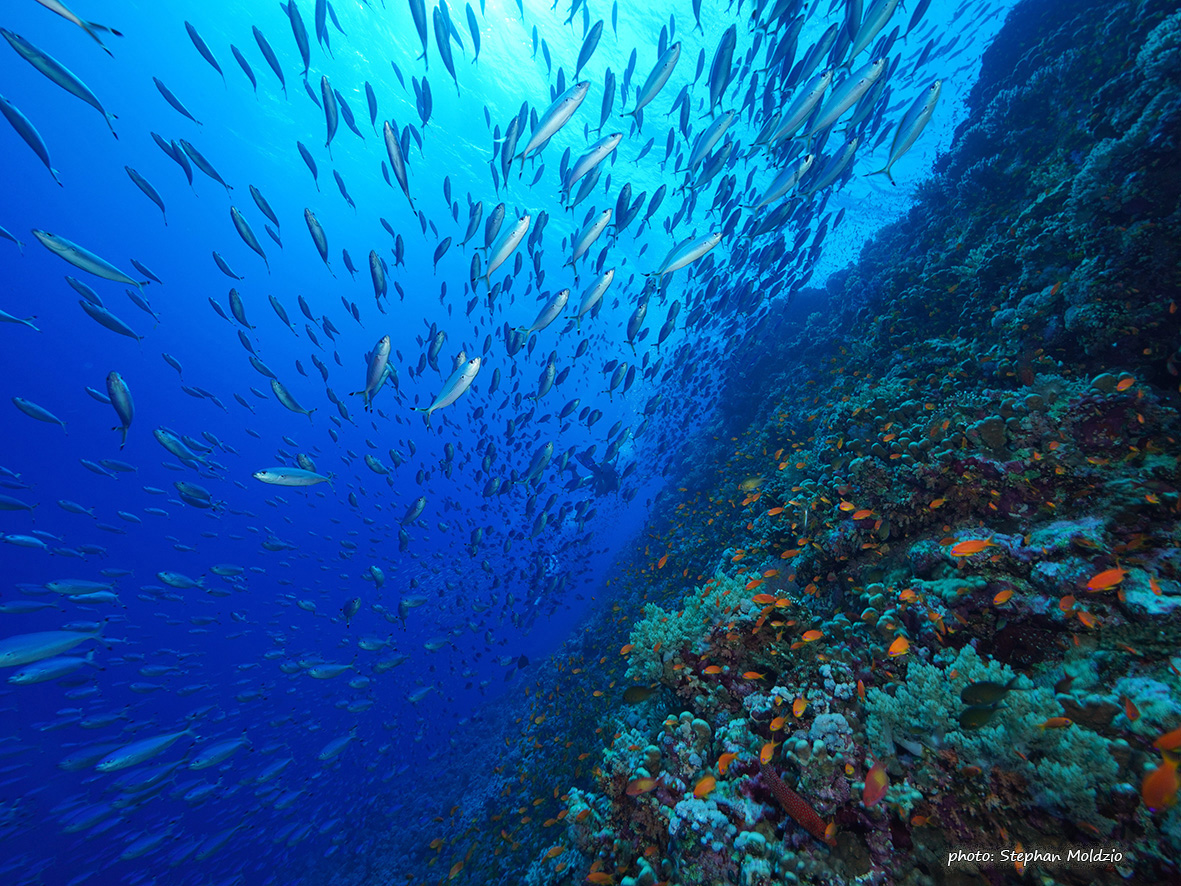
Dugongs im Roten Meer
This was also reported by marine biologist Dr. Ahmed M. Shawky in his interesting and vivid presentation about the dugong population along the Egyptian Red Sea coast. Ahmed also conducted an extra Dugong Specialty with our youngest diver: This specialty is part of a modular teaching program on Red Sea life specifically for children. Ahmed conducts this for school classes, among others, to instill respect and appreciation for the fascinating but fragile underwater world in even the youngest members of society.
A special highlight was the Zodiac trip to Long Canyon – already on the boat trip we met a group of spinner dolphins. One after the other we dived through a long tunnel system in the reef plateau of Shaab Abu Dabab. After leaving the canyon we visited a wreck at the end of the dive.
Marsa Shagra
At the end of our eventful stay we did some nice extended dives at the Marsa Shagra house reef. Especially the early morning dives at 6 am, but also the late afternoon dives, where you come out of the water shortly after sunset, have their special charm.
And of course the Night Dive – according to one of the participants who likes to do five to six dives a day, this is “the most important dive of the day”, which should be never missed:
During the nightdive, you can expect to see numerous whimsical invertebrates which are hidden during the day, as well as hunting moray eels. In some cases they were successful in their hunt before our eyes…
The big Mangrove Red Snapper “Fatima” is also a firm attraction during the night dive in the house reef, beneath countless other discoveries, surprises, or rare species.
The fascinating Basket Star is a speciman of huge brittle stars with finely branched arms, that emerges from the crevices of the reef only at night to catch plankton. In normal daylight it immediately retreats – we were able to observe it undisturbed with a red light lamp.
We also met the “Spanish Dancer”, a large and very elegant nudibranch of the Red Sea. Not to think if you should miss all this….
Finally, at the end of the journey, you can enjoy very nice also the magnificent sunrises and sunsets on a hill. With a view of the sea, the desert, the mountains … and Marsa Shagra Village.
